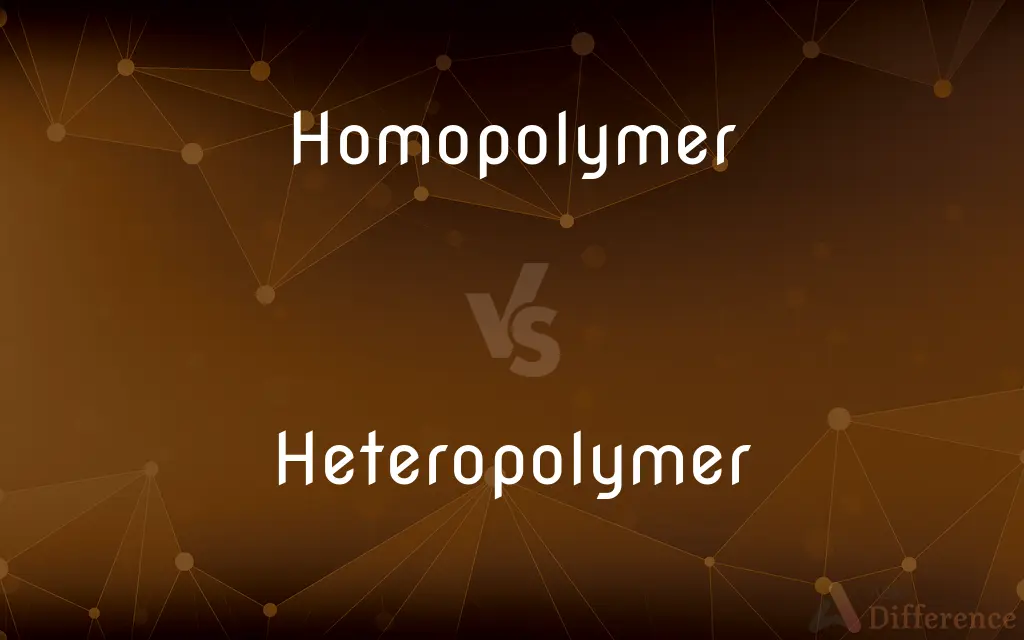Homopolymer vs. Heteropolymer — What's the Difference?
Edited by Tayyaba Rehman — By Fiza Rafique — Updated on April 22, 2024
Homopolymers consist of only one type of monomer repeated throughout the polymer chain, whereas heteropolymers are composed of two or more different monomers.

Difference Between Homopolymer and Heteropolymer
Table of Contents
ADVERTISEMENT
Key Differences
Brief Comparison: Homopolymers consist of only one type of monomer repeated throughout the polymer chain, whereas heteropolymers are composed of two or more different monomers.
Concise Explanation:
Homopolymers have a uniform structure due to the repetition of a single type of monomer, making them typically more predictable in properties, while heteropolymers incorporate a variety of monomers, resulting in a diverse range of characteristics and functionalities.
In terms of mechanical properties, homopolymers can be limited by the properties of the single monomer they contain, whereas heteropolymers can be engineered to achieve specific traits by varying the types and ratios of monomers.
The synthesis of homopolymers is often simpler and more straightforward, focusing on polymerizing a single monomer, whereas synthesizing heteropolymers involves more complex techniques that can handle multiple monomers and control their arrangement.
ADVERTISEMENT
Homopolymers generally offer consistency and ease in processing, which is beneficial for large-scale production of uniform materials; on the other hand, heteropolymers can be tailored to meet specific needs in applications like biocompatible materials, smart materials, or high-performance composites.
In application, homopolymers are well-suited for standard and general-use products like polyethylene in shopping bags, while heteropolymers are essential in specialized applications such as nylon in textiles, which require a combination of softness, strength, and durability.
Comparison Chart
Monomer Variety
One type
Two or more types
Mechanical Properties
Limited by single monomer
Adjustable, enhanced by different monomers
Synthesis Complexity
Simpler, one monomer polymerization
Complex, copolymerization needed
Application Consistency
High, due to uniform structure
Variable, tailored to specific requirements
Example Applications
Plastic bags, containers
Textiles, biomedicals, composites
Compare with Definitions
Homopolymer
Features uniform chemical structure.
The homopolymer's consistent structure contributes to its predictable properties.
Heteropolymer
Complex in structure and synthesis.
The synthesis of heteropolymers requires precise control over the co-polymerization process.
Homopolymer
Often used in standard manufacturing processes.
Homopolymers are preferred for bulk production due to their ease of processing.
Heteropolymer
Tailored for specific applications.
Biocompatible heteropolymers are designed for medical implants and tissue engineering.
Homopolymer
Typically more rigid and less complex.
Homopolymers lack the versatility found in more complex polymer arrangements.
Heteropolymer
Exhibits varied physical properties.
Heteropolymers can be engineered to be flexible, durable, or resistant to chemicals.
Homopolymer
A polymer derived from a single type of monomer.
Polyethylene, used in shopping bags, is a common homopolymer.
Heteropolymer
A polymer made from two or more different monomers.
Nylon, a heteropolymer, is crafted from diamine and dicarboxylic acid.
Homopolymer
Found in everyday plastic products.
Most household plastics are made from homopolymers due to their simplicity and cost-effectiveness.
Heteropolymer
Essential in advanced materials science.
Heteropolymers are crucial in developing high-performance materials for aerospace and electronics.
Homopolymer
(chemistry) a polymer formed from a single type of monomer
Heteropolymer
(chemistry) A polymer derived from two or more different (but often similar) types of monomer
Common Curiosities
What are the advantages of using homopolymers?
Homopolymers offer simplicity, predictability, and ease of manufacture.
Can a homopolymer be converted into a heteropolymer?
No, but a new heteropolymer can be synthesized using the same monomers plus additional types.
What are common examples of homopolymers and their uses?
Polyethylene in plastic bags and PVC in pipes are common homopolymers with widespread uses.
What are the advantages of using heteropolymers?
Heteropolymers provide versatility and can be tailored for specific functional properties.
What are common examples of heteropolymers and their uses?
Nylon in textiles and ABS in 3D printing are examples of heteropolymers with specialized applications.
What is a homopolymer?
A homopolymer is a polymer consisting entirely of one type of monomer.
What is a heteropolymer?
A heteropolymer, or copolymer, consists of two or more different monomers.
Why are heteropolymers important in medicine?
They can be designed to interact beneficially with biological systems, making them ideal for medical applications.
How is the production cost of homopolymers compared to heteropolymers?
Homopolymers generally have lower production costs due to simpler synthesis processes.
What role do heteropolymers play in sustainable materials?
They can be engineered to be biodegradable or to have lower environmental impact, enhancing sustainability.
Share Your Discovery

Previous Comparison
Feed vs. Fodder
Next Comparison
Diode vs. CapacitorAuthor Spotlight
Written by
Fiza RafiqueFiza Rafique is a skilled content writer at AskDifference.com, where she meticulously refines and enhances written pieces. Drawing from her vast editorial expertise, Fiza ensures clarity, accuracy, and precision in every article. Passionate about language, she continually seeks to elevate the quality of content for readers worldwide.
Edited by
Tayyaba RehmanTayyaba Rehman is a distinguished writer, currently serving as a primary contributor to askdifference.com. As a researcher in semantics and etymology, Tayyaba's passion for the complexity of languages and their distinctions has found a perfect home on the platform. Tayyaba delves into the intricacies of language, distinguishing between commonly confused words and phrases, thereby providing clarity for readers worldwide.














































